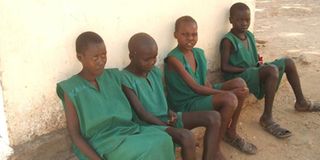Kala Azar; a neglected tropical disease tormenting Karamoja

Patients of Kala azar at DNDI treatment centre in Amudat. They are all dressed in green to differentiate them from other patients. PHOTO BY DAVID MAFABI
What you need to know:
Kala azar is a chronic and potentially fatal parasitic disease of the internal organs, affecting the liver, spleen, bones and the lymph nodes due to infection by the parasite called Leishmania donovani which is commonly associated with semi-arid regions.
With an emaciated body, Cheprai Ngolenyang, 13, turns uneasily on his mat, grimacing from the pain he is going through.
Ngolenyang has lost weight due to loss of appetite. With his prominent cheekbones and sunken eyes, he appears badly undernourished.
During a visit to Ngolenyang’s home in Akorkeya village, Abilibyeyi parish in Loro Sub-county in Amudat, his father Joseph Arupe Tomtomu claims his son has been bewitched at the anthill.
When children start to lose weight and become sickly in this area, it is believed that the children will not heal because they are suffering from the disease of the anthill.
Three days after Daily Monitor’s visit to his home village, Ngolenyang died at the Kala azar Treament Centre in Amudat.
Ngolenyang’s is not an isolated case. Many children who look after goats and cattle in Amudat, Nakapiripirit, Napak, Kotido, Kaabong and parts of Katakwi and Amuria [cattle corridor], especially those who live in mud and wattle houses are suffering from the same disease”.
According to Patricia Namohe, an LC I secretary for women affairs in Amudat Town, who lost two children to the same disease, most children who suffer from this disease usually die before making 15 years.
This is the reason why many sick children are kept indoors, where herbs are prepared and administered to heal them.
Namohe says, “There are times we have tried to take children to hospitals in Kenya and Uganda but most of them die and those who survive, are still weak due to the disease.”
In the case of Ngolenyang, Dr Patrick Sagaki in-charge of Amudat hospital, made a diagnosis of Kala azar.
According to Dr Sagaki, Kala azar is the most deadly parasitic disease after malaria and it is classified by the World Health Organisation (WHO) as a Neglected Tropical Disease (NTD).
Kala azar (visceral leishmaniasis) is a deadly disease caused by parasitic protozoa Leishmaniadonovani, transmitted to humans by the bite of infected female sandfly, Phlebotomus argentipes [Simulial]. The parasite is hard to detect with the naked eye.
“The vector thrives in cracks and crevices of mud-plastered houses, other poor housing, heaps of cow dung, in rat burrows, bushes and vegetation around the houses and near anthill,” says Dr Sagaki.
World Health Organisation [WHO] health reports by Dr Parasittisuk Chusuk on the disease reveal that a peculiar feature of Indian Kala azar is darkening of the patient’s skin, from which the name Kala (blackening)-azar (fever) is derived.
Reports at the new Amudat district health office indicate that the sub-region has long battled several animal diseases; Goat plague PPR (Pest des Petits Ruminants), bovine pleural pneumonia - an infectious livestock disease - and Bovine Tuberculosis which infects a variety of hosts including wildlife, domestic livestock and humans. And now the region is now fighting Kala azar, another neglected tropical disease.
Dr Patrick Sagaki who doubles as the medical superintendent at Drugs for Neglected Diseases [DNDi], the only Ugandan Kala azar Research and Treatment Centre in Amudat, says although Kala azar disease has been around for many years, the recent attacks have thrown residents into panic.
“We have so far admitted a cumulative number of about 226 since August 2008, admitting an average of 15 patients every month. Most of these cases come not only from Amudat but also as far as Rupa, Katikekile in Moroto and Kacheliba in Kenya within the cattle corridor,” says Dr Sagaki.
Kala azar is a chronic and potentially fatal parasitic disease of the viscera (the internal organs) affecting the Liver, spleen, bones and the lymph nodes due to infection by the parasite called Leishmania donovani which is commonly associated with semi-arid regions and is widespread in Karamoja region, particularly Nakapiripirit, Abim, Napak, Moroto, Kotido, parts of Teso and the new Amudat districts in Uganda.
Dr Sagaki says although medical reports in Amudat have long acknowledged the existence of the disease, the rates of infection in both people and domestic animals is poorly documented, let alone controlled.
Although many people in Karamoja regard Kala azar as a strange, mysterious disease, research has shown that cases of the disease have been recorded in Nakapiripirit, Amudat, Western parts of Kenya, Ethiopia and Sudan for close to 50 years.
“Through DNDi we have admitted and treated many Kal azar patients. We admit about 15 patients every month, usually boys of between six to 15 years because they are exposed and the rates of infection are still going up because it has now stretched from Amudat to Katakwi in Teso,” says Dr Sagaki.
Dr Sagaki reveals that there are many people who still don’t understand the disease and that those infected die within two years if they are not treated.
Information availed to Daily Monitor at the DNDi indicates that the strange disease has claimed lives of at least 46 people in the last two years and is likely to claim more if the ministry of health does not intervene to put in place measures to contain the situation.
The DHO Nakapiripirit, Dr John Anguzo, affirmed that many cases of Kala azar fever have been detected at Nakapiripirit but they are transferred to Amudat hospital and admitted at the treatment centre.
Dr Anguzo revealed that once bitten by the Simulial mosquito-like fly, a person will be infected by Kala azar fever and that once neglected without proper treatment, the patient usually dies after a period of two weeks.
Dr Lawrence Okello of WHO, also working with DNDi says whereas the disease is usually dormant during the scanty rainy season, it flares up during dry weather when the pastoralists travel long distances in search of water.
Dr Okello reveals that an enlarged spleen and liver are the main symptoms of the disease and that at primary level, the disease manifests in form of weight loss due to loss of appetite (anorexia), fever, cough, high body temperatures, anaemia, fatigue and epistasis (bleeding through the nose).
Ministry of Health says
Dr Thomson Lakwo, an assistant commissioner, at the national Entomologist for Onchocerciasis Control programme, NTD programme, Ministry of Health says there are no confirmed statistics yet about the burden of disease in Uganda but that the disease has been endemic to Amudat district and increasingly people from other districts such as Kotido, Moroto, Katakwi, Abim, Kaabon, Napak, Nakapiripirit and presently Amuria, Kaberamaido and Serere are presenting with it.
“We have not mapped so we do not know the extent of the disease in the country but more people from other districts are presenting with it,” says Dr. Lakwo.
Scientists working on neglected tropical diseases at the ministry of health in Uganda say the increased cases of Kala Azar could be due to increased awareness because many cases were not reported in the past.
“Also the Ugandan health system is getting more sensitive and picks disease problems that were previously not picked, says Dr Lakwo.
Local authorities
The LCV chairman, Mr William Bwatum says the strange disease could have been imported from neighbouring Kenya, particularly Turkana and Pokot, through cross border cattle raids by the warriors.
The District Health report for 2015 seen by Daily Monitor indicates that the strange disease has claimed lives of about 46 people in the last two years and is likely to claim more if the ministry of health does not intervene to put in place measures to contain the situation.
Records at the district also indicate that over 1000 domestic animals have died of the disease in the last five years and that the disease mainly affects the children between the ages of five to 16 years who look after goats.
Prof Joseph Olobo, a lecturer at the Immunology Department, College of Health Sciences, Makerere University, says they are training more health workers to treat the disease. He says Kala azar is treatable but fatal if left untreated.
The disease also affects mainly the world’s poorest populations, who live in arid or semi-arid regions of the world. Eastern Africa is the most affected region in Africa with an estimated annual incidence rate of 29,000 to 56,000 cases.
“70 per cent of kala azar patients are children and it affects more men than women because they spend more time outside looking after animals in the fields,” says Prof Olobo.
Treatment
Dr Okello says the disease attacks the poor living in mud and wattle houses, in the cattle-keeping semi-arid sub-region of Karamoja, where heaps of dung are dumped, near anthills. It is an expensive disease which the poor can’t afford to manage financially.
We usually give a combination of two drugs Sodium Stibogluconate [SSG] which is administered for 21 days with a balanced diet because the drug is very toxic.
“We actually give an egg every morning, milk, greens, beef, chicken, porridge, rice on top of the treatment and the patients have to be at the hospital for three weeks,” says Dr Okello.
Dr Okello says Leishmaniasis East Africa Platform (LEAP) has developed a new combination therapy (SSG&PM) which is cheaper and nearly brings the length of treatment from a 21-day course of injections to 17 days, but that it is yet to be used in Uganda.
He says there are other drugs which are expensive to use and these include Pentamidine Isethionate (Imported), Miltefosine (Imported) and Liposomal amphotericin B (local but expensive).
He adds “Kala azar treatment is painful and the treatment is fairly undignified involving a 30-day course of injections on the buttocks.
Challenges
Dr Sagaki and Dr Anguzo say most people are ignorant about the disease and usually leave their children in the homes to die.
“Amudat is the only treatment centre for Kala azar and given the remoteness of the place and the long distance, most people usually shy away,” says Dr Sagaki, adding, “And the numbers we talk about are the only ones that access the hospital yet there are many more who die of the disease in the villages after the treatment with herbs fails.”
One complete dose of treatment for 21 days of Miltefosine [oral] drugs costs Shs 200,000 [about US $600]. Given that those frequently infected are the poorest of the poor, they can’t afford the treatment let alone the feeding of their children.
He reveals that DNDi, a Geneva-based project with the African headquarters in Nairobi started technical trials for Kala azar treatment at Amudat centre but that few doctors are well-versed with the disease.
Children admitted at the ward for Kala azar told Daily Monitor “We get breakfast, lunch, dinner and supper throughout the day. We take milk, bread, beans, meat, rice, Irish potatoes, matooke, blueband and posho,”
“We actually feed well at times we don’t even think about going back home,” says Lolem Alamtore, 12 who is admitted at the DNDi centre.




